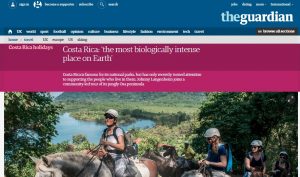
The-Guardian-Screenshot
it is not the first time, but it is a source of pride.
Costa Rica continues to be recognized in European media for its biodiversity and tourism.
On February 5th, British newspaper The Guardian published an extensive report that places the country as ‘the most biologically intense place on Earth’.
The publication focused on Corcovado National Park and on the Osa Peninsula surroundings.
Costa Rica’s Osa Peninsula, a former island that now makes up the southernmost reach of the country’s Pacific coast, was called “the most biologically intense place on Earth” by National Geographic. It crams 2.5% of the planet’s biodiversity into just 0.001% of its surface area. And, this being Costa Rica, 80% of it is protected, mostly by the Corcovado national park,
stated The Guardian.
The British media offers a guide of activities and tourist options to carry out in the country, something very different from what is usually known outside national borders.
Costa Rica developed its national parks system in the 1970s (…) It has been hailed as an outstanding conservation success, but community ecotourism initiatives are still brand new,
quoted the newspaper.
European and British tourists are part of the tourism authorities’ goal, due to the increase in flights that communicate the country with the ‘old continent’.